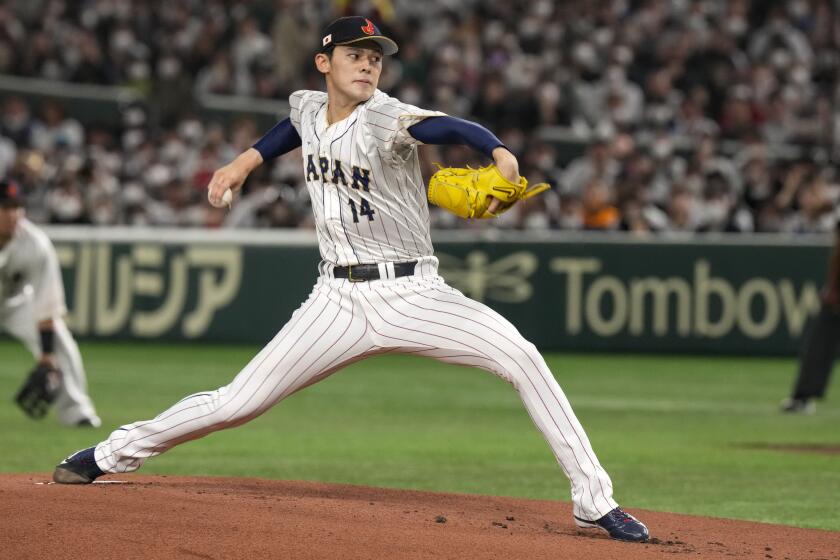Dodgers pitchers are quite the hit at the plate
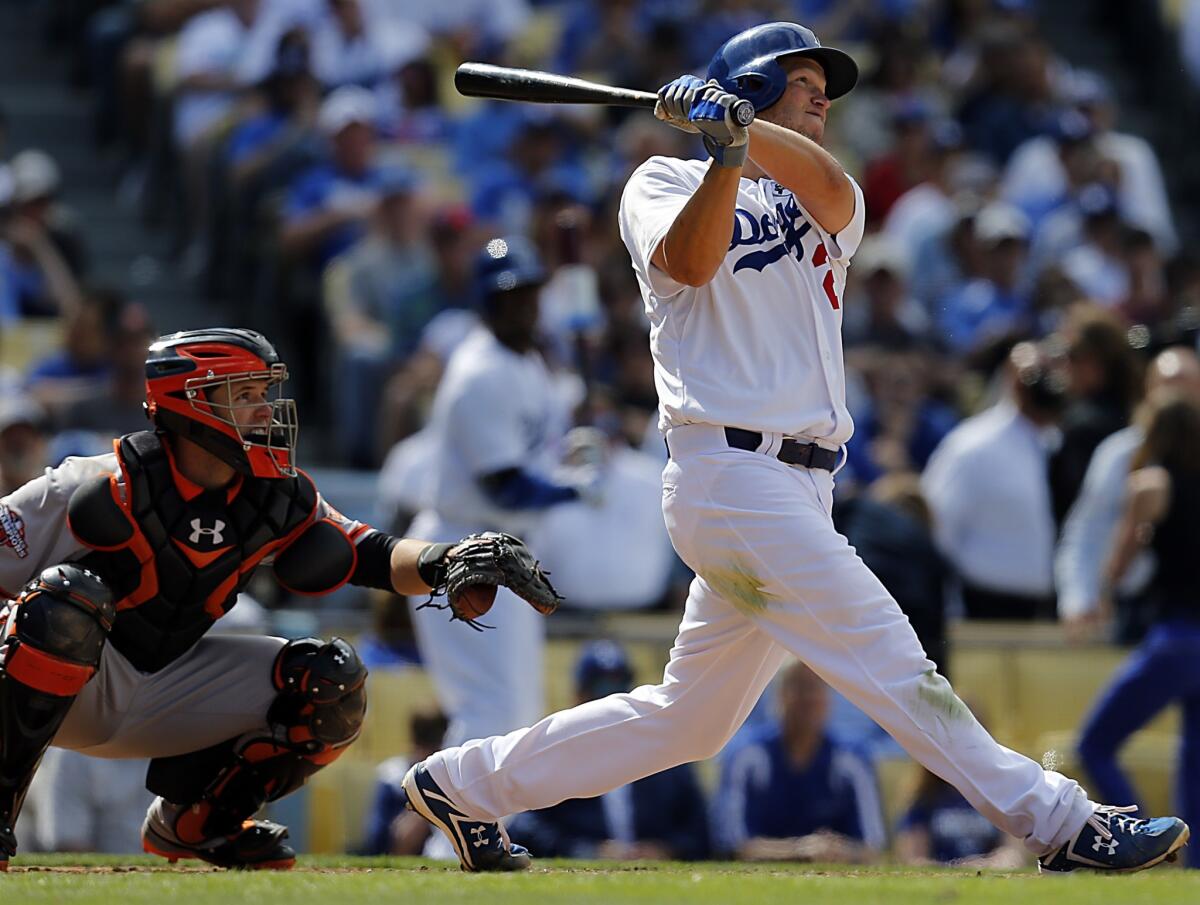
The Dodgers’ top four pitchers are hardly easy outs with bats in their hands. In fact, their combined batting average is a remarkable .231 with 20 runs batted in.

With two out and the bases loaded, the Dodgers needed a clutch hit to take the lead. Only one problem — the pitcher was up next.
Clayton Kershaw stepped to the plate looking tall and lanky, his stance slightly open.
"Obviously," he would later say, "hitting is not my main job."
It is a baseball axiom that pitchers don't make good batters. The guys who can throw 90-mph fastballs usually struggle to hit them.
The Dodgers, surging to one of the best records in the major leagues, have upended that notion.
This season, the team's top four starters — Kershaw, Zack Greinke, Ricky Nolasco and Hyun-Jin Ryu — have a combined .231 batting average with 20 runs batted in, which is better than some everyday players around the league.
"Any team would love to have that on the roster," said Mickey Hatcher, a former major league player and hitting coach. "Those guys are going to give you good at-bats."
Kershaw set the tone in the season opener with a timely home run against the rival San Francisco Giants. Now, in this recent game against the Miami Marlins, he was hoping to come through again.
The Dodgers' ace took the first pitch for a ball. Expecting a steady diet of outside fastballs, he was waiting for just the right one.

Pitchers don't get many chances to show their offensive skills.
Starters play once every five or six days and are often asked to sacrifice-bunt, which doesn't count in their batting averages. Relievers rarely stay in games long enough to bat.
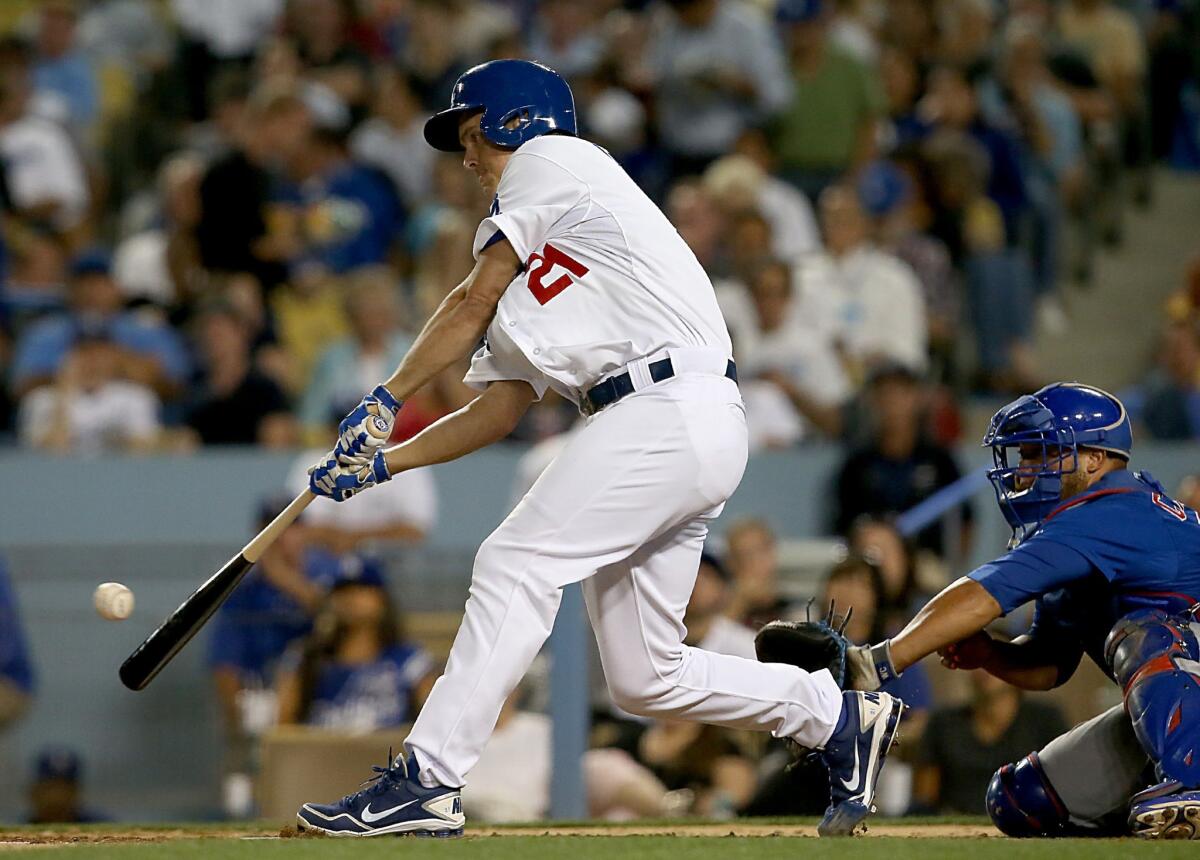
Dodgers veteran right-handed pitcher Zack Greinke connects for an RBI single against the Chciago Cubs in the fourth inning of a game recently at Dodger Stadium. Greinke, who is a lifetime .226 hitter, is batting a remarkable .347 this season with four RBIs. (Luis Sinco / Los Angeles Times) More photos
So the Dodgers have only the starters take batting practice, usually just before home games, giving them about 15 minutes before the rest of the team arrives at the cage.
"You don't put much time and effort into hitting," Greinke said.
The right-hander downplays his flashy .347 average. Kershaw has a similar attitude about his 10 runs batted in, saying: "We just stay loose and have fun."
The way they take batting practice suggests otherwise. One afternoon at Dodger Stadium, the pitchers began by laying down bunts, then worked on slashing the ball with short strokes, spraying hits around the field.
Little by little, their swings grew longer and more intent. The ballpark, still empty, echoed with a staccato beat of line drives and deep fly balls.
Greinke smacked one over the left-field wall and Ryu followed with a towering home run. Kershaw let out a hoot, hopping into the batting cage for his turn.
"They have a little game," pitching coach Rick Honeycutt said. "All the starters put in $500 and they have a point system."
Obviously, hitting is not my main job."— Clayton Kershaw
The wager means little to these multimillionaires — Greinke ranks among the game's highest-paid pitchers and Kershaw is expected to negotiate a mammoth contract extension this off-season — but the bragging rights are priceless.
Though the players hesitate to discuss their side game, it seems that home runs in batting practice count for something. So do walks, hits and runs during games. Failing to bunt a runner to the next base subtracts from the total.
As Greinke steps into the batting cage, his lips twist with concentration. The look confirms this is serious business.
Honeycutt believes the unofficial competition has translated into results on the field for a team that leads the National League West by 12 1/2 games. The coach likes it, as long as his guys warm up beforehand, work on their bunts and don't pull any muscles by swinging too hard.
"Batting practice should not just be a homer-fest," he said.

A lot of major league pitchers start out as the best players on their Little League and high school teams, adept at all phases of the game. Their offensive prowess diminishes as they devote more time to throwing.
"We don't take as many swings as the position players do," Kershaw said. "But we still have a little bit of talent."
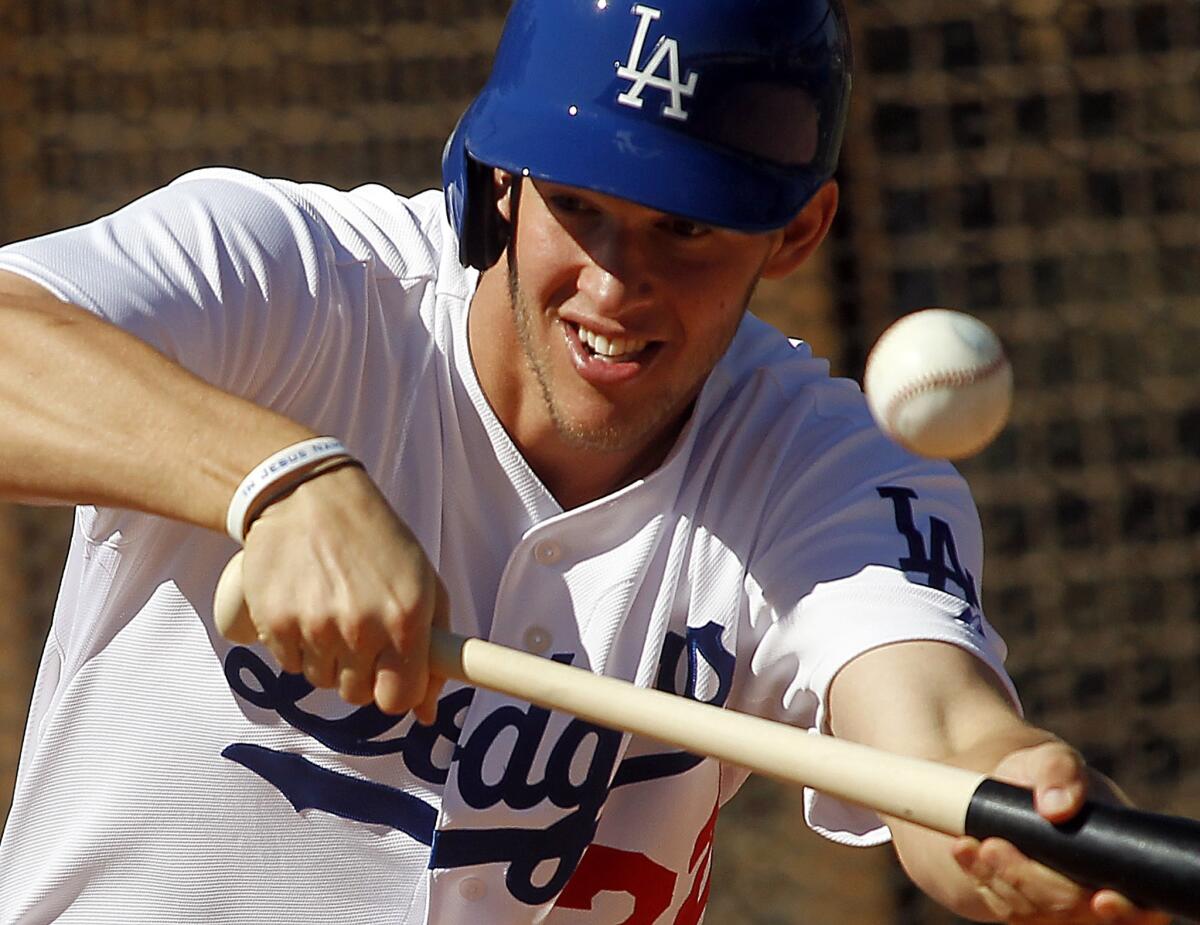
Dodgers left-hander Clayton Kershaw practices bunting during spring training at Camelback Ranch. He has has seven sacrifice bunts this season. (Luis Sinco / Los Angeles Times) More photos
Babe Ruth, who began his career on the mound before shifting to the outfield, was obviously skilled at the plate. Walter Johnson could handle a bat and Don Larsen hit .306 with 13 runs batted in for the New York Yankees in 1958.
The Dodgers have some history too, with the likes of Don Newcombe, Fernando Valenzuela and Orel Hershiser recording .300 seasons during their careers. The current staff is attempting to follow in that tradition.
Though the number of dual-threat players has diminished since the American League adopted the designated hitter in 1973, Dodgers batting coach Mark McGwire doesn't see any reason why pitchers shouldn't develop their offensive skills.
"It just depends on how hard they want to work," he said. "If I was pitching in the National League right now, I'd want to be the best hitter possible."
McGwire tries to keep things simple, telling the pitchers to swing at the straight stuff and, when possible, lay off anything that curves or dips.
They have not only hit for average but have played crucial roles on offense — Kershaw had two hits, including a two-run single that gave the team a lead, at Colorado on Monday.
Teammates have come to expect big things.
"It's crazy," outfielder Matt Kemp says. "Every time Greinke pitches, if he doesn't get any hits ... I tell him he had a bad game."

The Dodgers held a slim lead over the Chicago Cubs in Chavez Ravine last week when Nolasco came to the plate with runners on first and second, none out.
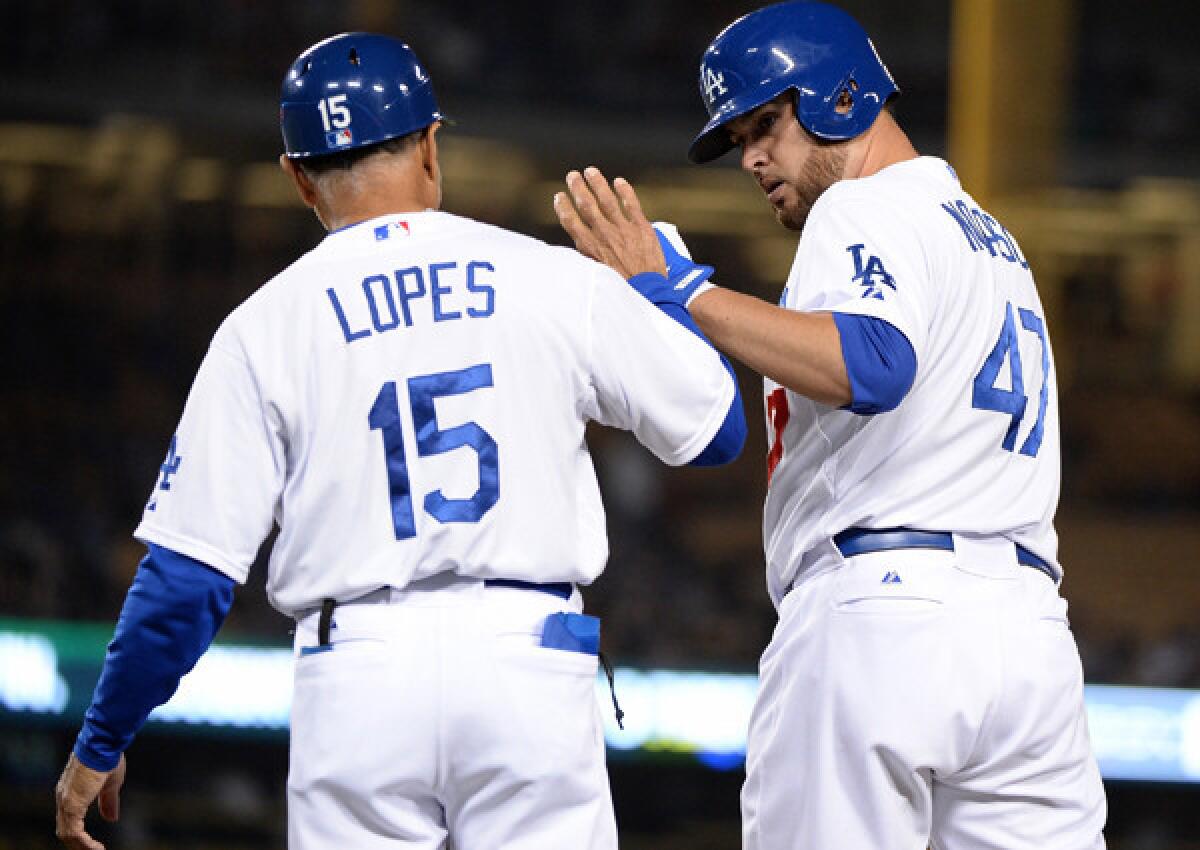
Veteran pitcher Ricky Nolasco is congratulated by first base coach Davey Lopes after getting a hit against the New York Mets last month. (Harry How / Getty Images) More photos
The situation called for a bunt to draw the third baseman off the bag, forcing a throw to first and allowing the runners to advance.
Nolasco's first attempt bounced foul — he could not get the right angle on an outside fastball. Then, with the first baseman creeping in, he changed tactics and chopped at the ball.
"The guy was pretty much down my throat," he said. "So I tried to slash it at him, but I missed."
The next two pitches were low, evening the count at 2-2. Finally, on the fifth pitch, Nolasco saw something he could use.
The right-hander makes for an intimidating figure when he squares to bunt, his 235-pound body hunkered down, leaning forward over the front of the batter's box. The ball came off his bat softly, dribbling between the mound and the third base line, which left Cubs starter Edwin Jackson with a difficult play.
Jackson scooped up the bunt but skipped his throw past the third baseman, allowing Juan Uribe to score. The Dodgers had widened their lead on the way to a 4-0 victory.
Nolasco shrugged it off.
"It wasn't a great bunt," he said. "But I was able to get it down."

July was a good month for Greinke, his average soaring to .400 with eight hits, including a pair of doubles.
He is slightly built, with quick reflexes and the quiet demeanor of a man determined to succeed. At one point during the summer, the Dodgers used him as a pinch-hitter — rare for a pitcher — and he got on base with a walk.
"I went through a hot stretch where every time I swung, I hit it good," he said.
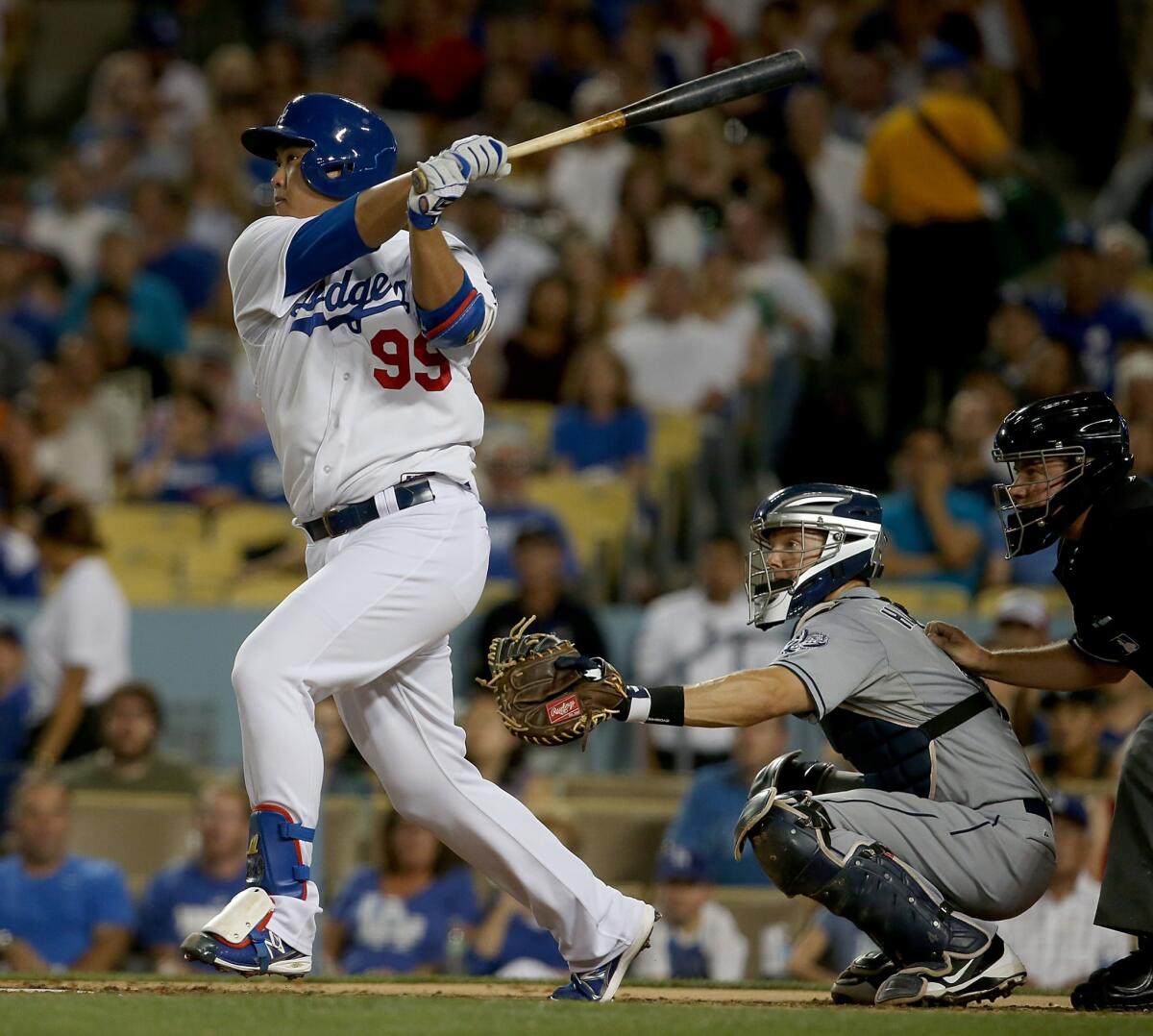
Dodgers rookie pitcher Hyun-Jin Ryu follows through on a run-scoring double against the San Diego Padres. (Luis Sinco / Los Angeles Times) More photos
In a close game at St. Louis last month, the team needed his help. Coming up in the seventh inning, Greinke reached down for a dipping curveball and sent it into center field, driving home Nick Punto.
That run made the difference in a 3-2 victory.
"I can't remember the last time a pitcher hit that [pitch] for a hit, much less an RBI hit," Cardinals starter Adam Wainwright said.
The other Dodgers pitchers have kept an eye on Greinke's average, hoping to catch up before season's end. As Honeycutt said: "He's made them all want to get better."
Ryu recorded a three-hit game against the Arizona Diamondbacks that had television announcers referring to him as "Babe Ryuth." Kershaw had his chance during the recent Miami game.
After taking the first pitch, he put a smooth swing on an outside fastball. His head stayed down and his hands were quick — classic technique. With a sharp crack, the ball rocketed into left, driving home Yasiel Puig to give the team a 1-0 lead.
It was the third consecutive start in which Kershaw had driven in at least one run.
"I don't know why," he said. "I've just been getting hits."
So, on top of everything else — Puig's emergence, Hanley Ramirez's sparkling play, Adrian Gonzalez's consistency, the contribution of bench players — opponents have something else to worry about.
The ninth spot in the Dodgers' batting order is no easy out.
Follow David Wharton (@LATimesWharton) on Twitter
Follow @latgreatreads on Twitter
More great reads
A virtual way to be with their deported friend
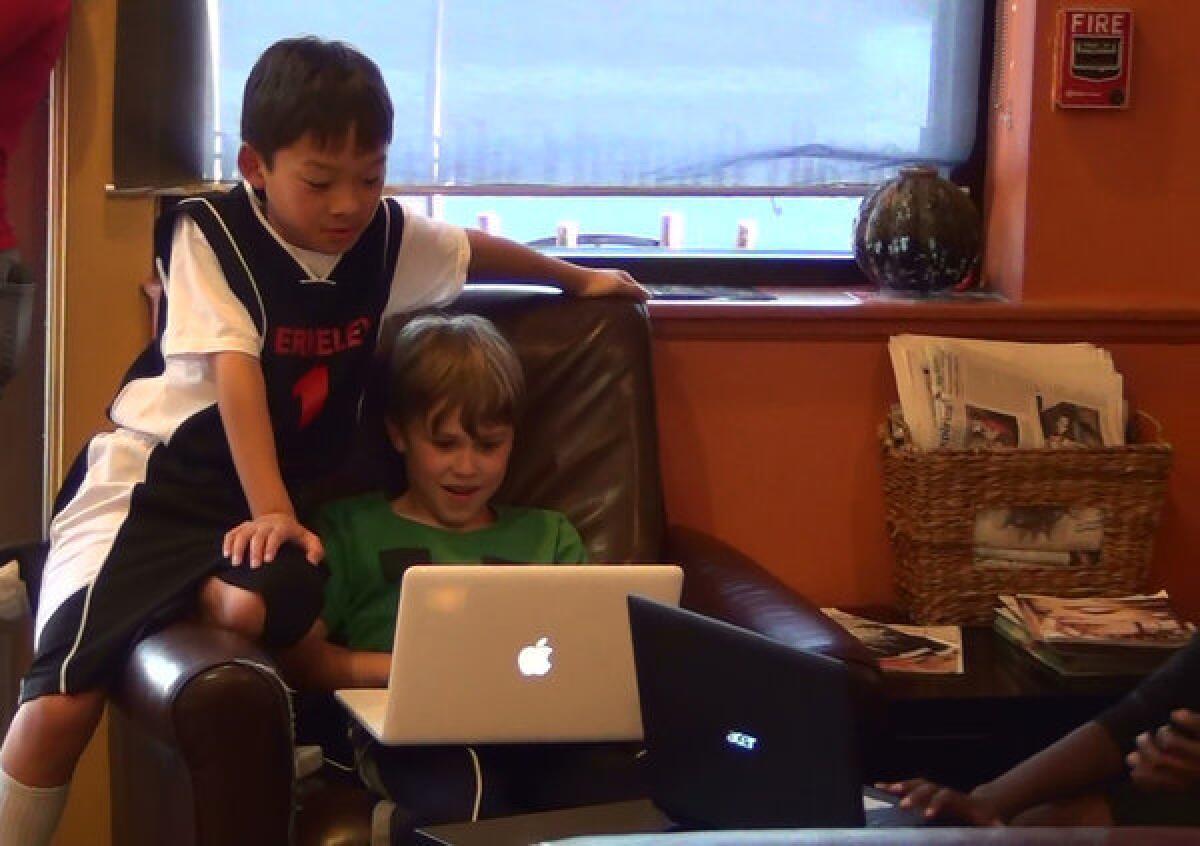
The more we learn about immigration, the more unfair it seems."
An adopted son discovers more than he expected
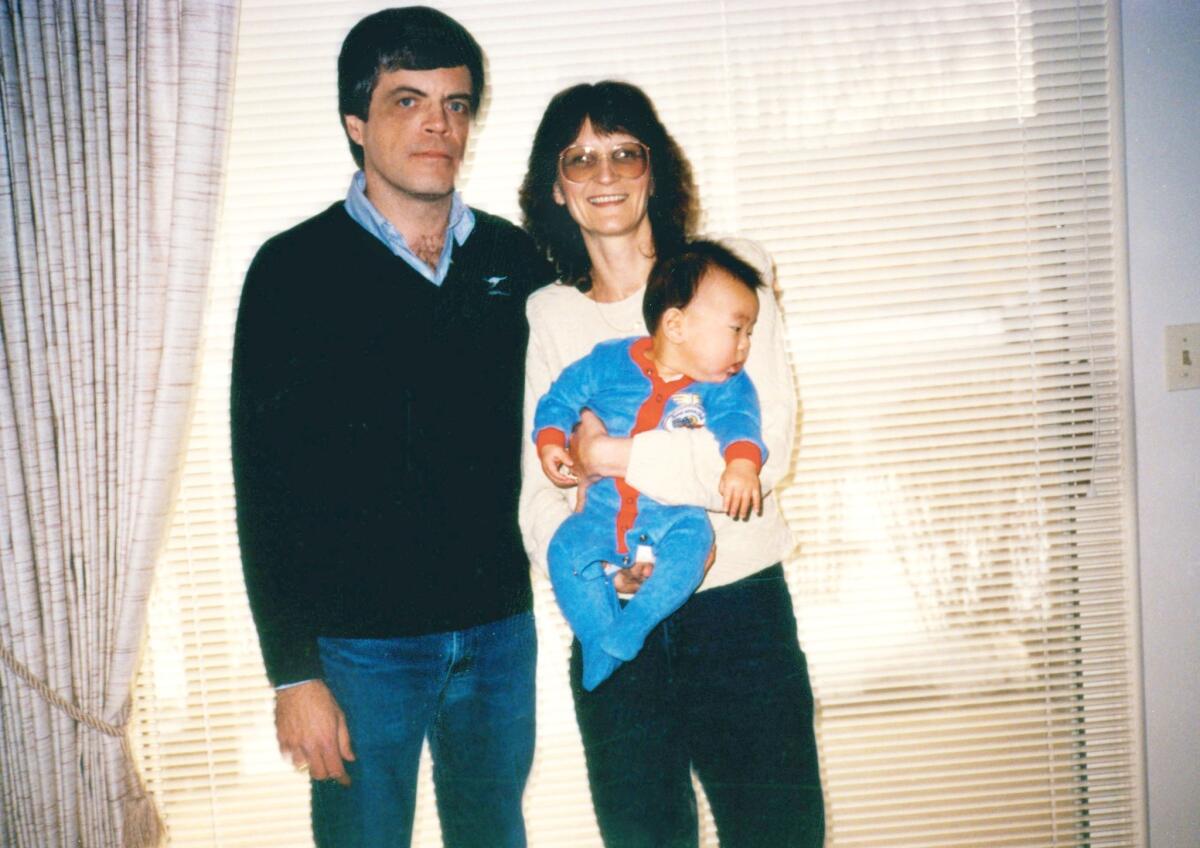
I had misjudged the magnitude of this meeting — both for my biological mother and for me."
Are you a true-blue fan?
Get our Dodgers Dugout newsletter for insights, news and much more.
You may occasionally receive promotional content from the Los Angeles Times.



